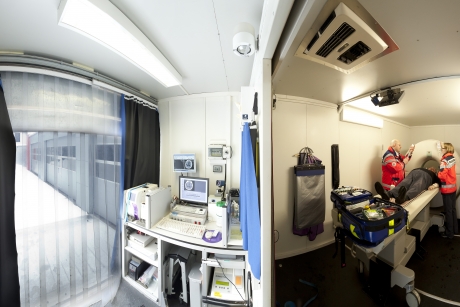Clinical laboratories will increasingly provide emergency diagnostic services through mobile-unit near-patient testing
In an innovation designed to bring the laboratory to the patient, use of a mobile stroke unit (MSU) shortened the time to treatment decision for acute stroke patients. MSUs equipped with imaging systems and medical laboratory point-of-care testing proved capable of providing early diagnosis and intervention.
Pathologists and clinical laboratory managers will immediately recognize the implications of these findings. This study demonstrates how clinicians are taking steps to move clinical laboratory testing out of the traditional central/core laboratory and bring it closer to the patient specifically to reduce the time-to-answer for certain medical conditions, like acute stroke.
One conclusion from this clinical study is that use of a mobile stroke unit offers a potential solution to the medical problem of stroke patients arriving at the hospital too late for treatment, wrote researchers in a study published in the medical journal The Lancet.
New Timescale in Acute Stroke Management
A single-center study by researchers in Germany found that an MSU team embedded with emergency medical services (EMS) reduced the time to making a treatment decision by a median 41 minutes compared with standard care.

Here are two interior photographs of the mobile stroke unit (MSU) designed by the Department of Neurology and Psychiatry at the University of Saarland in Germany. The ambulance is equipped with a computed tomography (CT) scanner, point-of-care (POC) clinical laboratory test devices, and a telemedicine system. The MSU was able to shorten shortened the time from alarm to therapy decision for acute stroke patients. (photo by Land-der-Ideen.de.)
“[The trial] has shown convincingly that in at least some settings a [mobile stroke unit]-based service is feasible and can substantially reduce delays to treatment,” Klaus Fassbender, M.D., Professor and Chair of the Department of Neurology and Psychiatry at the University of Saarland in Homburg, Germany, and his colleagues reported in The Lancet.
The purpose of the study was to assess the efficacy of starting diagnosis and treatment at the emergency site, rather than after hospital arrival. “Only 2-5% of patients who have a stroke receive thrombolytic treatment, mainly because of delay in reaching the hospital,” the researchers noted in their report.
In the trial, targeted patients received prehospital stroke treatment in a specially-outfitted ambulance, equipped with a computed tomography (CT) scanner, point-of-care laboratory (POCT), and telemedicine connection, stated MedPage Today in its coverage of the new study. The control group received optimized conventional in-hospital stroke treatment.
Moving Early Diagnosis and Intervention Closer to the Patient
The MSU study primary objective was time from alarm to therapy decision. Among the secondary endpoints were times from alarm to end of CT and to end of clinical laboratory analysis.
“Prehospital stroke treatment reduced the median time from alarm to therapy decision substantially,” the authors wrote. “We also detected similar gains regarding times from alarm to end of CT, and alarm to end of laboratory analysis.”
Healthcare providers have been looking for ways to reduce delay in diagnosis and treatment of stroke victims. In a study published last year in the Annals of Neurology, researchers examined the feasibility of gaining valuable time in routine hyperacute stroke management in the hospital setting. “Usually, stroke laboratory examinations are performed in the centralized hospital laboratory,” wrote the authors of that study. In the trial, however, researchers transferred the complete guidelines-based stroke laboratory workup to a point-of-care (POC) laboratory system placed at a stroke treatment room contiguous to CT. According to the study, the strategy halved the door-to-therapy-decision time.
The University of Saarland’s MSU approach took this concept one step closer to the patient. The researchers concluded that, for patients with suspected stroke, treatment by the MSU substantially reduced median time from alarm to therapy decision.
However, Robert Glatter, M.D., Emergency Medicine Specialist at Lenox Hill Hospital in New York City, cautioned that the new trial showed no differences between the study groups in neurological outcomes a week later, MedPage Today reported.
Plus, he pointed out that there was no difference in the number of patients who actually received thrombolytic therapy. Even so, Glatter acknowledged that the concept of a mobile stroke unit “is a promising approach to more rapidly and effectively assess and treat patients with acute strokes in the field.”
Clinical laboratory managers and pathologists will note how this study shows that the healthcare system will increasingly seek to bring testing closer to the patient as technological advances makes that feasible. A further noteworthy observation is that the medical laboratories involved in these types of arrangements will want to capture the lab test data generated by mobile units and integrate that data into their laboratory information systems (LIS).
—Pamela Scherer McLeod
Related Information:
Mobile Stroke Unit Speeds Time to Treatment
Point-of-care laboratory halves door-to-therapy-decision time in acute stroke
Mobile Stroke Unit Improves Stroke Diagnosis And Treatment Time
Mobile Stroke Unit Saarland – Schlaganfallrettungswagen: Jede Minute zählt



